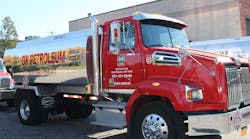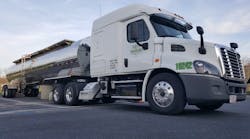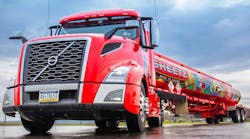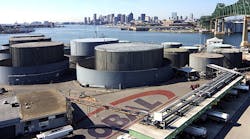ALUMINUM, steel, composites—each has their strengths and weaknesses as a material to use in manufacturing trailers. During a recent trailer manufacturing conference in Canada, builders whom specialize in using a specific material explained the advantages and disadvantages of their favorite material.
For Butch Medemblik, manager of engineering and plant operations for Walinga Inc and a past president of the Canadian Truck Equipment Association (CTEA), composites are something to explore in greater detail.
Based in Guelph, Ontario, Canada, Walinga started trailer manufacturing in 1954, using the slogan “Building Any Body For Anybody.” Cornelius Walinga and John Medemblik began handcrafting wooden truck bodies for local businesses.
Throughout the decades as each new technological advancement became available, Walinga incorporated it into the manufacturing process. In 1955, Walinga built its first cattle and feed hauler. Walinga introduced grain vacuums in the late 1970s and was the first producer in North America to use a positive displacement system to transfer grains at a greater rate of speed with less horsepower, using smaller lines. The company also pursued the elimination of wind resistance by bringing the unit closer to the road and re-imagining protruding ribs and braces, and making better hydraulic systems and high-output augers so trucks run less, consuming less fuel.
Now it is moving into composites to drive unit weights down. Strength-to-weight ratios are important, as is a new material’s ability to withstand the trials of daily use.
“We are working with a third-party composites manufacturer and an innovations center,” Butch Medemblik said. “Most of our equipment hauls animal feed. We’re looking for ways we can make our customers more competitive. Through the years, there have been weight challenges. Aluminum is a big part of what we do, but with the advancement in composites we felt compelled to look at it in 2015.
“The application possibilities are wide and broad. It is important for each of us to keep looking forward. We manufacturers need to look for new ways so consumers can haul more payload and be safer to protect our operators and to be progressive. Composites are just one area to consider. The only constant today is change. Those of us who adapt will be in better place to survive. That is part of the roadmap to success that the association is trying to promote.”
Why manufacturers should explore composites:
• Design flexibility. “Composites have an advantage over other materials because they can be molded into complex shapes at relatively low cost. The flexibility of creating complex shapes offers designers a freedom that is a hallmark of composites achievements.”
• Durability. “Composite structures have an exceedingly long life span. The longevity of composites, along with their low-maintenance requirements, is a major benefit in critical applications. There are many well-design composite structures constructed over 50 years ago that are still active today.”
• Corrosion resistance. “Com-posite products provide long-term resistance to severe chemical and temperature environments. Composites are often the material of choice for outdoor exposure, chemical handling applications, and severe environment service.”
• High strength. “Composite materials can be designed to meet the specific strength requirements of an application. A distinct advantage of composites over other materials is the ability to use many combinations of resins and reinforcements, and therefore to custom tailor the mechanical and physical properties of a structure.”
• Light weight. “Composites are material that can be designed to have light weight and high strength. In fact, composites are used to produce structures with the highest strength-to-weight ratio known to man.”
• Conductivity. “Composites have the characteristics to help reduce the risks due to electrocution. Trucks with booms or similar apparatus are often at risk.”
Medemblik said there is a great value proposition for composites, using examples of where they’re used in other industries. Composites are materials that can:
• Make bridges that don’t rust, and in the process double their lifespan.
• Make tanks that don’t leak gasoline into our groundwater and pipes that don’t leak and corrode, to deliver fresh water or take away sewage.
• Make boat hulls that don’t rot.
• Make vehicles better looking and more fuel-efficient.
He said the price of composites has come down dramatically, from $150 a pound in 1970 to less than $5 in 2008.
In terms of corrosion resistance, composites are great in chemical storage, where they displace stainless steel and exotic materials; sewer pipes, where they displace concrete, ductile iron, and clay; hog farrowing floors, where they displace concrete and wood; and concrete rebar, where they displace steel, stainless steel, and coated steel.
He said composites can lower costs in installation/shipping, maintenance/repair, and manufacturing.
In manufacturing, that comes in the form of parts consolidation, the facilitation of complex shapes, the support of a wide range of production rates from one to thousands, and low investment costs in equipment and tooling.
Considerations when planning to use composites:
• Composites are simply another material system.
• Like any material, they are not the best solution for all product applications—trade studies are required.
• There are many different composite materials—each with a unique set of attributes.
• There are many different composite processes. Each process has strengths and limitations for specific materials, shapes, performance, and production volumes.
• Composite design should not imitate both form and function of an existing design in another material.
• Take advantage of part consolidation wherever possible.
• Ensure composites will support any critical standards your products need to comply with.
• Tooling is generally hard to change once built—get it right the first time.
• Tooling is expensive for first article but can be used to manufacture many units. Cost per unit is low in volume production.
• Use composites to provide added value and competitive edge, and try to incorporate styling or features not previously possible.
Walinga is looking at using composites in its Animal Feed Discharge Auger—a trailer that delivers finished animal feed from a feed mill to a farmers bin using a steel auger system driven by hydraulic power.
The reasons:
• Durability and longevity. “Animal feed can be corrosive and abrasive. Abrasive products wear out primary metals such as steel and aluminum, albeit it’s more of a concern for aluminum than steel. Wear due to abrasion removes material and therefore affects the structural strength of the discharge auger.
• Corrosion resistance. “Steel discharge augers rust over time. Rust for many fleet owners is a huge appearance and image issue. For steel units, this can be overcome with processes such as galvanizing, but this adds more cost and weight.”
• Weight reduction. “Weight of a composites auger will be comparable to an aluminum version. A composites version would give much enhanced strength and abrasion resistance as compared to aluminum. The design can be done to put the strength where it is required—enhance the section modulus to make it comparable in strength to a steel version at a significant reduction in weight.”
“We are very new to composites and we don’t have a full understanding of what it takes to put a good composites project together,” he said. “So we’re looking at different types of material to make the best product with a targeted weight reduction. Right now, we’re looking at a very thin aluminum inner section with composites on the outside.
“The important things are to: think outside of the box; choose a project carefully; do your research and do it right; design for composites because they do not have the same protocols as the more traditional materials; partner with a reputable composites firm; and choose the right composites materials for your application. Composites might not be for you but you won’t know unless you carefully study it.” ♦








